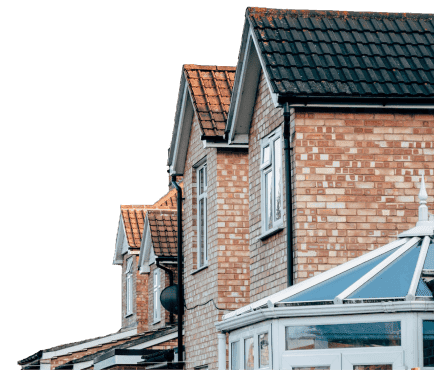
Recently, the cost of renting a property hit its
highest figure in over a decade. Prices have risen by
8% in the last six months alone, with rent now
accounting for an
average of 28% of peoples pre-tax earnings.
This is despite hundreds of thousands of homes sitting
vacant across Great Britain.
We’ve gathered
data from local councils to see where the most homes
are going unused, and where they’ve been empty the
longest.



Overall vacancies
Using Gov data
According to government data, there are currently 313,471 properties in Great Britain that have been vacant for six months or longer. These properties are classed as ‘long-term vacant’, with Scotland being home to the highest proportion - 16 per every 1,000 homes.
Vacant property breakdown
Using FOI data
We used Freedom of Information Requests submitted to all councils in England, Scotland and Wales to see where homes had been vacant for the longest. Throughout Great Britain, 135,183 homes have been left unattended for a year, while a staggering 15,925 have been sitting empty for over 11 years.

Long-term vacancies by council
Using Gov data
The City of London had more long-term vacant properties than any other area of England. Per every 1,000 homes, 38 have been empty for over six months, while in Barrow-in-Furness, it’s 26, and in Liverpool, it’s 22. In Scotland, the Shetland Islands were found to have 48 vacant properties per 1,000, while in Wales, Carmarthenshire has 26.
Search for a council in England, Scotland or Wales to find out how many long-term vacant houses there are per 1,000 properties.
Extended Vacancies
Using FOI data
A long-term vacancy is defined as a home that’s been left empty for at least six months, but we wanted to investigate those homes that have gone unlived in for much longer. We asked councils across Great Britain for information on how many properties had been vacant for two years or more. Choose a country and time period below to see how the homes near you fare.

The value of vacant homes
Using FOI data
Homes being left empty doesn’t just make the
housing market harder to get into. It also costs
the economy, as vacant homes don’t contribute
rental income, mortgages or deposits.
Using median house price data, we found that in
England alone, an estimated £22.2 billion has been
lost on properties vacant between two and four
years. The City of Westminster contributes £1.5
billion to this, more than any other council area.

Councils with the biggest variations in empty houses
Using Gov data
Some councils have seen big increases in the number of vacant properties. Spelthorne in the South East saw vacant properties go up by 341% between 2021 and 2022, while West Dunbartonshire in Scotland saw a 34% increase, and Conwy in Wales saw vacant homes go up by 21%.

Commentary
From our research, it became clear that there is disparity between the number of empty homes in Great Britain and the number of households waiting for social accommodation.
While councils and charities continue to work on solutions, we wanted to understand the nuances behind the figures of empty homes in relation to social housing waiting lists. So, to gain further insight on the situation, we reached out to the housing charity Greater Change and spoke to the Co-founder and CEO, Jonathan Tan.
Jonathan Tan - Co-founder and CEO of Greater Change
"There are over 1.2 million households on the waiting list of council housing in England. Of these, 21% can be housed into long-term empty properties."
While the data suggests that long-term empty properties could potentially accommodate up to 21% of the current housing demand, it's crucial to understand that the actual percentage of habitable properties is likely significantly lower. Moreover, the estimated total of individuals experiencing homelessness is suspected to surpass the officially recorded statistics.
Numerous factors contribute to properties remaining vacant long-term, rendering the full 21% not necessarily feasible for social housing conversion. These factors may include the property being a holiday home, requiring extensive renovation, or being entangled in legal proceedings.
Consequently, it's crucial to ask: What barriers are preventing these properties from becoming viable homes, and what are the economic challenges involved? Such exploration can offer valuable insights into addressing homelessness and housing shortages more effectively.
Local housing allowance rates and universal credit rates have been frozen since April 2020 levels, making private renting unaffordable to those on benefits. We at Greater Change are actively campaigning alongside our partners, different coalitions and homelessness charities to see the benefits rates rise to protect people who are the most financially vulnerable and give them the ability to afford to live.
"What conditions make a home inhabitable?"
While civil engineering issues often factor into the habitability of a home, it’s important to address the economic barriers that can also hinder access to housing. For example, our work includes funding adaptations, furnishings, rent deposits, and initial rental payments, helping to reduce the friction of moving people into homes.
Many properties are left bare of basic necessities like fridges, cookers, or washing machines, which can make a property unlivable. Moreover, we also assist individuals with disabilities by providing grants for necessary home adaptations.
Health and safety issues, such as dangerous floorboards or unheatable homes, can also pose challenges. In an era of energy crises, these issues can compound to create environments that fail to meet basic living standards.
We firmly believe in providing more than just a roof or a dwelling – we aim to provide a home. Our philosophy is that when individuals are given a home that feels nice, they take better care of it. This not only improves their living conditions but also transforms their outlook on life.
Jonathan's background